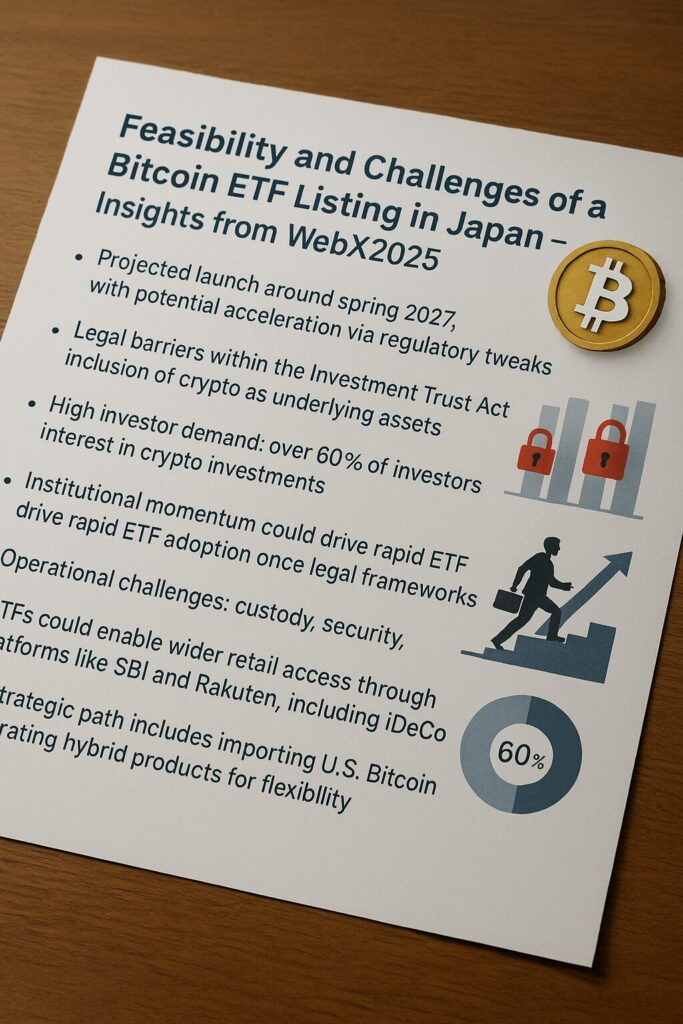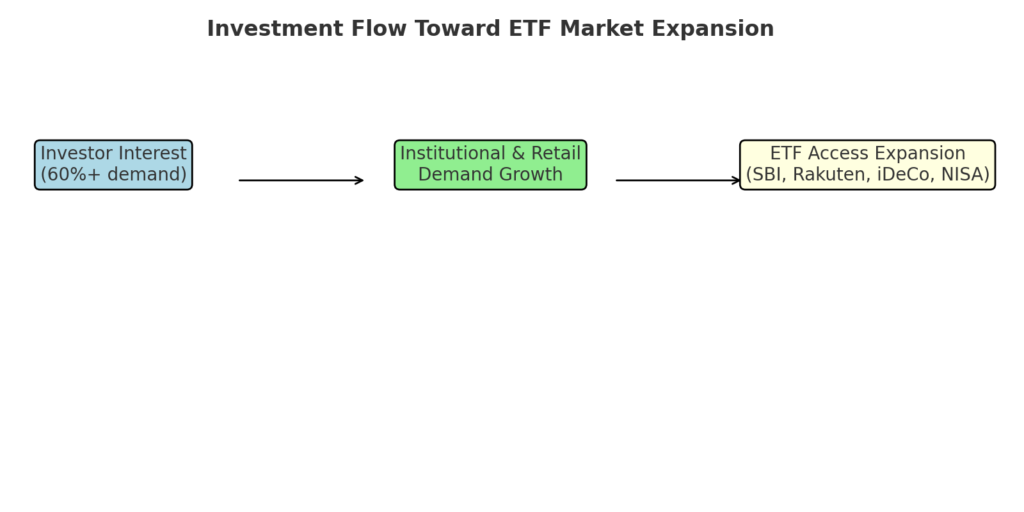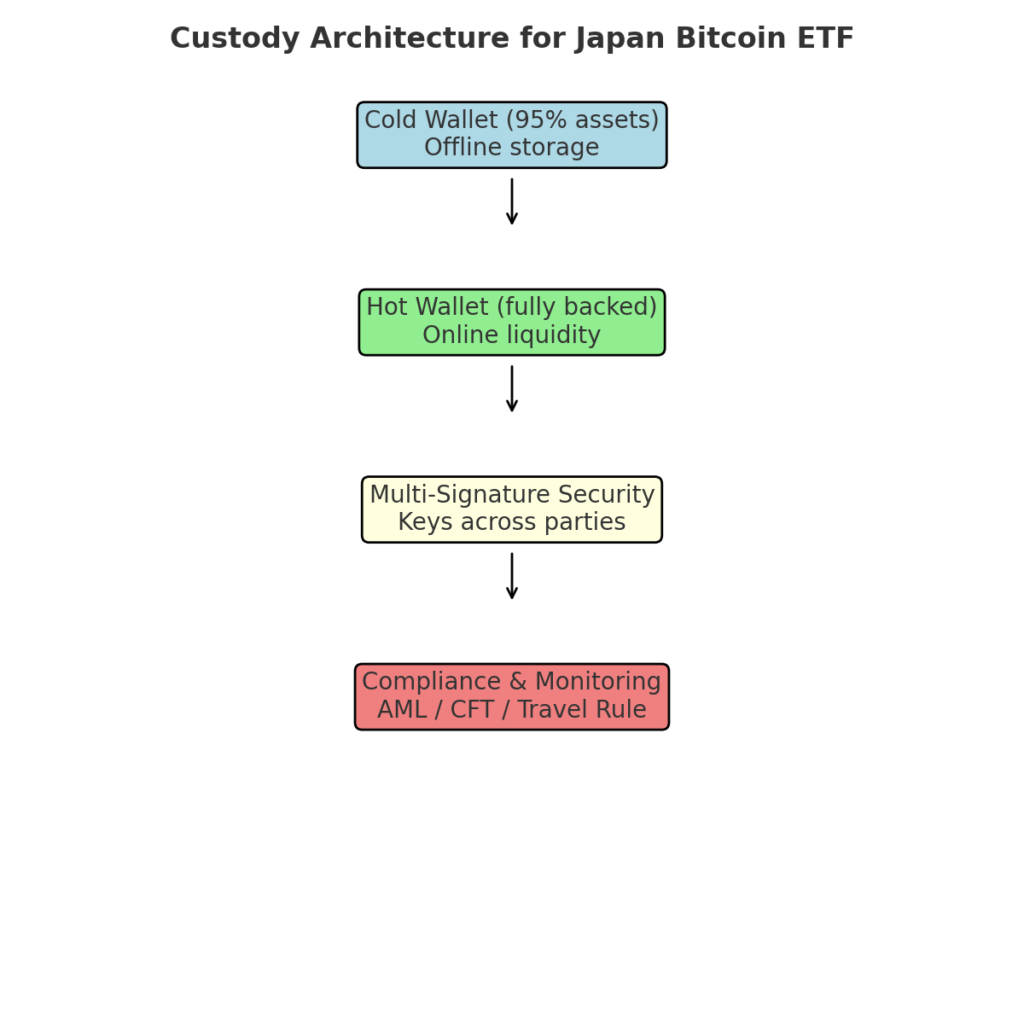
Main Points :
- Projected launch around spring 2027, with potential acceleration via regulatory tweaks
- Legal barriers within the Investment Trust Act restrict inclusion of crypto as underlying assets
- High investor demand: over 60% of investors express interest in crypto investments
- Institutional momentum could drive rapid ETF adoption once legal frameworks are set
- Operational challenges: custody, security, compliance, and transaction monitoring
- ETFs could enable wider retail access through platforms like SBI and Rakuten, including iDeCo and NISA
- A strategic path includes importing U.S. Bitcoin ETFs or creating hybrid products for flexibility
Projected Timeline and Acceleration Possibility
At the WebX2025 event, held August 25–26 in Tokyo, experts debated the timeline for a Japan‑listed Bitcoin ETF. KPMG’s Kenji Hoki explained that if tax reform proposals are adopted in next year’s legislative cycle, implementation could occur by spring 2027. However, he noted that if handled via executive orders rather than statutory amendments, a launch as early as next year is not entirely ruled out.

Legal and Regulatory Barriers
Japan’s Investment Trust Act currently disallows crypto assets from serving as underlying assets in investment trusts—the vehicle for ETFs. Moreover, regulatory guidelines effectively restrict such products. That leaves no consensus within industry or regulators for change at present.
Investor Demand Trends
Nomura executive Hajime Ikeda highlighted a survey showing that over 60% of investors are keen to invest in cryptocurrencies in some form. SBI’s Tomoya Asakura added that institutional investment could be contagious—once more than 5% of institutional managers begin allocating to crypto, others may follow urgently. On the retail side, with ~12.5 million crypto exchange accounts already in existence, broadening ETF availability through major brokers and investment services could significantly expand the market.

Paths to Broader Market Access
Asakura discussed pragmatic solutions, such as wrapping a U.S.‑listed Bitcoin ETF within a Japanese investment trust—pending regulatory guidance. This approach could pave the way for long‑duration investment products, potentially includable in iDeCo and company pension schemes.
Operational and Security Challenges
Ikeda underscored that robust custody frameworks will be critical. Key technical must‑haves include secure management of private keys, segregation between cold and hot wallets, multi‑signature implementations, on‑chain monitoring, and adherence to AML/CFT and travel rule requirements.

A New Choice for Long-Term Asset Formation
Asakura sees Bitcoin ETFs fitting into Japan’s “from savings to investment” shift. He noted their low correlation with traditional equities and bonds, making them a powerful diversification instrument for portfolios and a potentially attractive option for investors who previously invested only in stocks.
Recent Developments & Additional Context
Regulatory Momentum and Tax Reform
Recent reports confirm that Japan is targeting a 2027 launch of a regulated Bitcoin ETF, aligning with global peers. Reform of the Financial Instruments and Exchange Act to formally classify crypto as “specified assets” is expected between 2026–2027. Revised enforcement orders could open the door sooner to futures‑based or foreign‑wrapped ETFs.
Simultaneously, the Financial Services Agency (FSA) is advancing crypto tax reform—proposing a flat tax rate of approximately 20% (down from the current progressive up to ~55%) and enabling loss‑carryforward over three years. This aligns crypto tax treatment with stocks and bonds and establishes a foundation for crypto ETFs.
Industry Movements
SBI Holdings announced initial plans for two crypto‑linked ETFs: a Bitcoin–XRP dual crypto fund and a hybrid gold‑crypto fund. However, SBI later clarified these remain at the planning stage with no filings submitted yet.
Regulator’s Position
FSA and the Finance Minister have affirmed the importance of cryptocurrencies as diversification tools. At WebX2025, Minister Katsunobu Kato acknowledged crypto’s volatility but signaled government efforts are underway to secure a proper regulatory investment environment.
Custody Architecture
Japan’s emerging custody model—mandating cold storage for 95% of customer assets, hot wallet backed by full reserves, third‑party audits, and pre‑assessment of crypto by a self‑regulatory body—positions the country as a security‑focused model in line with institutional expectations.
Conclusion
Japan is approaching a pivotal moment in its crypto evolution. The momentum from WebX2025 and parallel initiatives—from legal reforms to tax restructuring and industry plans—are converging toward the potential launch of a regulated Bitcoin ETF by 2027. While formidable legal and operational hurdles remain, the robust investor demand and institutional preparatory signals cannot be overlooked. Effective solutions—such as foreign ETF wrappers, dual‑asset offerings, and stringent custody frameworks—could expedite adoption. For readers seeking new crypto opportunities or pragmatic blockchain applications, the unfolding ETF narrative in Japan is ripe with strategic relevance and emerging potential.

